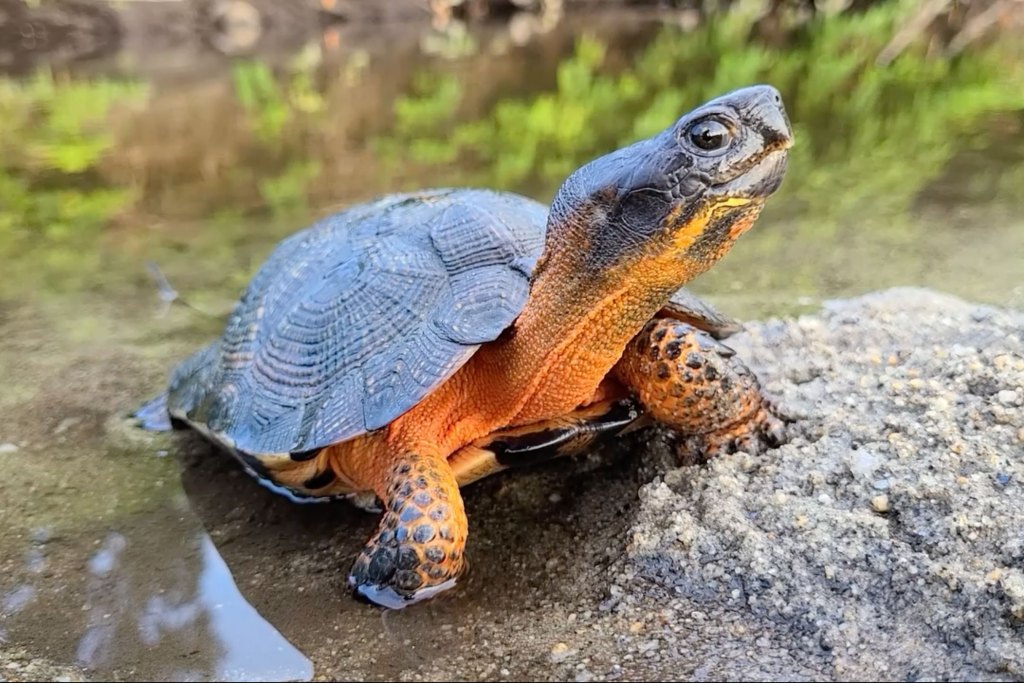While spiny softshell turtles are threatened in Vermont and spotted turtles are endangered, wood turtles could soon be threatened in the state due to land use change. That is why the state’s Fish & Wildlife Department is watching the species closely before more serious intervention is required.
The wood turtle, a medium-sized reptile native to Vermont, is known for the striking orange coloring on its neck and the inside of its legs, creating a unique, easily recognizable pattern. This pattern has also resulted in a growing demand for wild-caught turtles on the international black market.
But that’s not the only threat to these reptiles. Invasive species, like Japanese knotweed, are a major hazard, because they overrun sand and gravel bars where wood turtles would typically lay eggs. Moreover, repeated flooding in Vermont has caused the eggs to drown, and since the species has low reproductive rates, that can severely impact local populations.
Those threats have caused the department to identify wood turtles as a species of greatest conservation need in Vermont.
On Tuesday afternoon, two wildlife technicians waded through cool, bubbling streams and traversed muddy riverbanks in central Vermont to conduct one of the final wood turtle surveys of the season.
Kiley Briggs, the director of conservation at The Orianne Society, a nonprofit organization focused on protecting and restoring habitats for rare reptiles and amphibians, and Molly Parren, a turtle technician with the Vermont Fish & Wildlife Department, stepped out of the pick-up truck to put on their boots and waders. Briggs retrieved his antenna and radio telemetry from the pick-up truck.
“With radio telemetry, (first) we attach a small transmitter onto the turtle,” Briggs said. “The transmitter sends out a radio signal, which basically beeps and then we use an antenna and a receiver to determine what direction that beep is coming from, and then we follow it until we find where the turtle is.”
Briggs is collecting baseline data — the preliminary data that allows biologists to determine where the hotspots are for turtles and their population in those places.
Vermont’s streams provide ample habitat for wood turtles, but their ability to nest and grow the population is becoming increasingly difficult, Briggs said. As invasive Japanese knotweed spreads, female turtles are forced to travel farther in search of suitable nesting sites, further jeopardizing the species’ survival.
“We’re just getting turtles that are 40-50 years old and none that are in their 20s. That tells us: ‘Here is a problem that needs to be addressed at this site,’” Briggs said.
Due to the longevity of wood turtles — some may surpass 80 years old, as well as their low reproductive rates and slow maturation, their populations are sensitive to any threat that kills adults or removes them from the population.
“They only start laying eggs at the age of 20, which results in taking a long time to replace a population,” Briggs said.
Wood turtles spend time in water and on land but prefer to nest in river valleys — which also happen to be the best places for farms and the easiest places to build roads, Briggs said. When wood turtles spend time on land, they can be killed by tractors or run over by cars.
“Cars are a problem for all of our turtles, but for wood turtles especially, and I’ve lost turtles that were run over by farming equipment,” Briggs said. In some cases, the loss of just one or two wood turtles a year due to human causes can lead to a significant population decline or extirpation, according to The Orianne Society.
But conserving wood turtle habitat can benefit landowners. Federal programs in the U.S. Farm Bill offer financial assistance to landowners and farmers who establish riparian buffers.
After walking along a stream, Briggs, wearing polarized glasses in knee-deep water and carrying the antenna, found a turtle. It was located under the river bank, too far to grab, so he walked farther. After crossing the stream another two times, more than an hour later, Briggs found a new wood turtle in the stream that he hadn’t marked yet.
Both Parren and Briggs were excited to have found a new, seemingly young turtle and started immediately logging its data, including weight and length, in an online form on Briggs’ phone.
“With wood turtles, with males, on the bottom of the shell, is concave, that’s a male trait. As with females, the bottom of the shell is flat,” Briggs said. “For the age, we can count growth rings on their shells, kind of like counting the rings of a tree.”
The newly discovered turtle was approximately 15-years old. Wood turtles grow for the first 15-20 years of life, but they can live up to 50-70 years. As they age, their shells gradually wear down and become smoother, a trait biologists use to estimate their age. This turtle’s lighter yellow tissue in the center of his shell indicated he is still growing, according to Briggs.
“It’s rare to see a new young turtle in this location,” he said, since the site is prone to intense summer floods. “The biggest concern now is, if we have frequent summer floods, (for) many, many years, it might be too much flooding for the population to survive.”
However, at one site where a dam causes frequent summer flooding, nearly all the turtles chose to lay their eggs in upland habitat, safely away from the river, Briggs said.
“I wonder if that was them responding,” Briggs said. “The turtles know that the site floods a lot, but that’s just my interpretation of their behavior there.”
Read the story on VTDigger here: From invasive weeds to floods, the wood turtle is at risk in Vermont.

